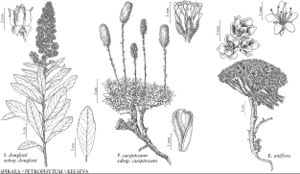Kelseya
in N. L. Britton et al., N. Amer. Fl. 22: 254. 1908.
| Taxon | Illustrator ⠉ | |
|---|---|---|
 | Spiraea douglasii var. douglasii Petrophytum caespitosum subsp. caespitosum Kelseya uniflora | Marjorie C. Leggitt Marjorie C. Leggitt Marjorie C. Leggitt |
Shrubs, densely cespitose, pulvinate, mat-forming, 0.3–1 dm; caudices woody. Stems 1–20+, semierect to prostrate and decumbent with very short internodes, densely, intricately branched, leafy; bark brown to gray or dark gray in age; short-shoots usually present, long-shoots rarely present; glabrous. Leaves persistent, cauline, alternate, tightly crowded and imbricate, simple; petiole absent; blade oblanceolate to spatulate-obovate, 0.2–0.4 cm, coriaceous, margins flat, entire, venation not visible, surfaces sericeous. Inflorescences terminal or pseudoterminal, flowers solitary, hirsute to villous; bracts absent; bracteoles absent. Pedicels absent. Flowers 3–6 (–8) mm diam.; epicalyx bractlets 0; hypanthium hemispheric, 1–2 mm, sericeous; sepals 5, erect to slightly reflexed, oblanceolate; petals 5, pink to pinkish, often purple-tinged, elliptic to oblong; stamens 7–12, slightly longer than petals; torus annular to weakly developed and inconspicuous; carpels 3 or 4 (or 5), free, glabrous or glabrate, sparsely villous on adaxial margin, styles terminal, adherent to hypanthium; ovules 3–5. Fruits aggregated follicles, 3–5, ellipsoid, 2–3 mm, glabrate or sparsely hirsute, sparsely villous on adaxial margin; hypanthium persistent; sepals persistent, erect to slightly reflexed; styles deciduous. Seeds 1 or 2 (–4), elongate, fusiform. x = 9.
Distribution
nw United States
Discussion
Species 1.
The phylogenetic work on the Rosaceae by D. Potter et al. (2007) and the nucleotide sequence data analysis of the Spiraeeae by Potter et al. (2007b) identified a clade containing Kelseya, Petrophytum, and Spiraea. A cladistic and numerical taxonomic study using morphologic characters ascertained that Kelseya and Petrophytum were nearest neighbors (J. Henrickson 1985). The work of Potter et al. (2007b) suggested that the reduced growth habit in the Spiraeeae evolved at least twice. The carpels of Kelseya are adherent to the hypanthium and each has an independent vascular supply of three bundles per carpel (C. Sterling 1966). Using Spiraea trilobata as a model (R. C. Evans and T. A. Dickinson 1999b) for gynoecial development in Kelseya, the five primordia are initiated separately and grow independently, yet simultaneously, with the intercalary growth of the hypanthium that occurs between the point of insertion of the perianth and the androecium. As the carpels of Kelseya mature, they become adherent to the hypanthium (Sterling); the carpels of S. trilobata remain free from the hypanthium (Evans and Dickinson). In contrast, in the Maloideae (J. R. Rohrer et al. 1991, 1994) and in Sorbaria and Vauquelinia (Evans and Dickinson), the region of hypanthial intercalary growth extends proximally from the gynoecium, and as the hypanthium and carpels develop, the abaxial margins of the carpels become adnate to the growing hypanthium. The adherence of the carpels displayed by Kelseya, found more typically in other genera of Pyreae and Amygdaleae, appears to be an unusual morphological feature that may be a result of the reduction in plant stature and habit possibly associated with its xeric alpine habitat.
Selected References
None.
Lower Taxa
"thin" is not a number.